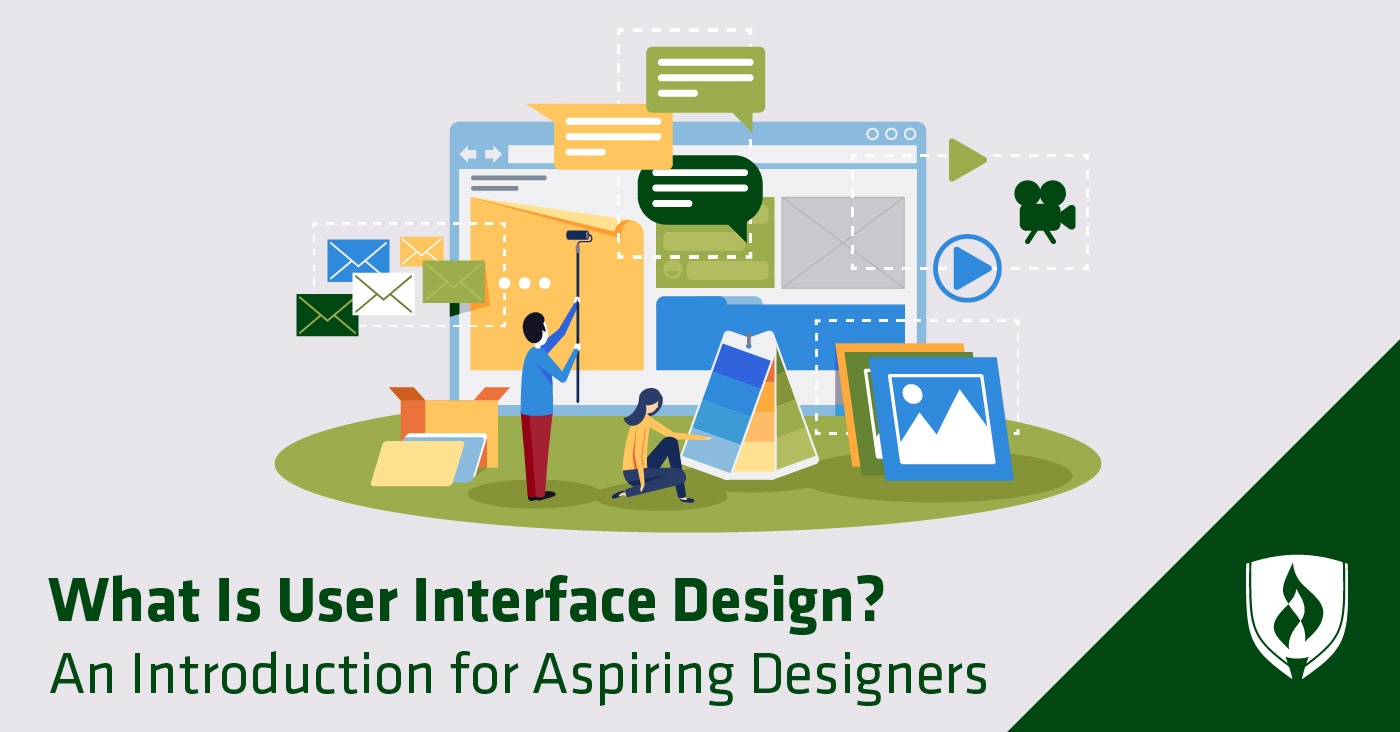What Is User Interface Design? An Introduction for Aspiring Designers
By Callie Malvik on 12/07/2020

You’ve always been a creative person, and the idea of earning a living in a career that lets you put that creative energy to use certainly sounds appealing. The good news is that there are plenty of solid creative career options out there—now you just need a little help making sense of them all.
One design niche that may have caught your eye is user interface (UI) design. While the term might have you thinking of futuristic sci-fi technologies, this design discipline is very much focused on the practical needs of users today. In this article we’ll provide a simple guide to what user interface design is, why it matters and what you’d need as a design professional to thrive in this specialty.
What is user interface design, anyway?
In design, an interface is where human users can provide inputs to computers or machines. While that may sound abstract, every day you’re surrounded by examples of this. The touch screen on your mobile phone, the menu system from your TV remote and the apps you use every day all have an interface that relays information from computer to user and vice versa. UI design aims to make that interface intuitive, easy to use and aesthetically pleasing.
“The focus is on maximizing usability and creating experiences that are simple and pleasurable,” says Steve Johnston, product manager at Infragistics.
Why is UI design important?
Think of it this way: You could have the most powerful tool in the world, but if it is confusing and difficult to use, people will give up on it and move on to something that is simpler to figure out and works well enough. In most cases, the “tool” a UI designer is working with is a piece of software or a website, and users have some pretty clear expectations for how they should work. That’s where a related discipline—user experience—comes into play.
The work of a user experience (UX) professional is to better understand a user’s “journey” when interacting with a site or piece of software. They want to understand what information users find most important, where they’d expect to find it, how they’d get to it, how they’d interact with it and more. Additionally, they seek out user information for pain points or areas that make the overall experience clunky or less-than-ideal. Once gathered, they provide recommendations for improvement.
“A ‘good’ user interface is usually the result of both a strong UX and UI design process,” says UX designer Andreas Johansson.
A user interface is a huge piece of the UX puzzle. Do icons make sense for what they represent? Does the layout have a logical flow? Can information be found where it’s expected to be? Does this lead to users doing what the project owner wants them to do—like sign up for information, make a purchase, or post to a feed? By having a coherent and well-designed system, you make products easier to use, which in turn can drive positive results.
What design elements does UI design influence?
The short answer: practically everything! The overall look and feel of an interface is a cumulative effort—buttons, typefaces, icons, imagery, white space, layouts, interaction responses and color palettes all come together to produce a coherent system. While a UI designer might spend time focused on creating an individual element found within an interface like a button or menu bar, that work isn’t done in a vacuum. It needs to fit an overall framework while also being technically feasible.
What do new designers need to know about UI design?
There’s a lot to master in this design niche and not all of it will come at once. That being said, there are a few things the design professionals we spoke with suggest you keep in mind when getting started.
1. You’re designing for a purpose, not yourself
This is a fairly universal issue for all designers, regardless of specialty. It’s easy to get caught up in your own grand idea of what would look good for a project—but you’ll need to stay grounded and keep your employer’s needs and the needs of the user in mind as well. While balancing it all may add an additional layer of difficulty to your work, Johansson says making it work can be rewarding.
“The best part of design work is the problem solving,” Johansson says. “Good design is about solving problems, both for the business and for the users. Then you have to balance the business value and user value with what's technically feasible to do.”
2. Your design needs to work for a variety of devices
“In UI design you need to design for multiple screen resolutions (responsive design) and have your design translate well in all of these formats. The same goes if you design apps,” Johansson explains. “Then you need to make sure you understand the technical constraints as well as how the design will be translated to an actual screen.”
For many design projects, your canvas is more-or-less static and your design will only need to work for one type of layout. With UI, you’re often working with displays on mobile devices, tablets and desktop computers that come with a variety of dimensions and potential technical roadblocks. You’ll need to be thoughtful about how to keep a consistent look and feel, no matter the users’ device.
3. Accessibility matters
Unlike a “flat” design of a billboard or a poster, an interface is interactive and should aim to maximize accessibility. Will visually or hearing impaired users be able to utilize this interface? Is there enough contrast in this design to make text easily readable? What can you do to provide alternatives? These are the types of questions you’ll also need to keep in mind while developing design elements for an interface.
4. Less is more
UI design can be a tough task. Clients will often want to cram as much information, features and assorted bells and whistles into a design or layout, but it’s on you to keep the user in mind. Sometimes that means cutting back on the client “wish list” or finding ways to condense this information into something that is easier to use and navigate.
“Less experienced designers may try to squeeze too many elements into the design even if the overall aesthetic looks nice,” says Stephanie Williamson, experience designer at Hudson Integrated. “Being able to strip elements out that aren’t necessary while still providing enough direction to guide the user is the sweet spot.”
Williamson adds that it’s important for UI designers to occasionally pause, take a step back, and critically evaluate whether or not a design element or component is actually needed for success.
What does it take to become a user interface designer?
Unlike becoming a nurse or an accountant where there are very clearly defined educational paths to each role, the path to becoming a UI designer isn’t as straightforward. This is a relatively new discipline that requires a unique skill set.
To help you get a better understanding of the skill set and training needed, we used real-time job analysis software to examine more than 12,000 UI designer job postings. The data helped us identify some of the top skills employers are seeking.
Here’s what we found:1
- Adobe Creative Suite®
- UX Wireframing
- UI design
- Prototyping
- JavaScript®
- Graphic design
- User research
- Web design
- HTML5
- CSS
- Usability testing
As you can see from the list above, this is a role that often requires a mix of graphic design and web development abilities—but the specific skills required may vary by employer. Some may be looking for professionals with a more extensive web design and development background, while others may see that as a “nice-to-have” skill set.
“You do not necessarily need to know front-end development—it's a bonus if you know some CSS—but you need to know the medium that you are designing,” Johansson explains.
Williamson says it’s always helpful to have a good grasp of front-end development. “In theory, you can design anything but that doesn’t mean it’s possible from a development perspective,” she says. “Having an understanding of HTML and CSS will allow you to think about what’s realistic when you’re designing and ultimately how it will function once developed.”
Take the first step
The path to becoming a user interface designer can start in many places. No matter the route you choose, having a strong grasp of design principles and how to convey information visually is a huge piece of the puzzle. The Graphic Design programs at Rasmussen College can help lay the foundation by developing the skills and competencies needed to navigate the world of professional design with confidence.
1Burning-Glass.com (analysis of 12,333 user interface designer job postings, Nov. 1, 2019 – Oct. 31, 2020)
Adobe Creative Suite is a registered trademark of Adobe, Inc.
JavaScript is a registered trademark of Oracle Corporation.
EDITOR'S NOTE: This article was originally published in 2014. It has since been updated to include information relevant to 2020.




